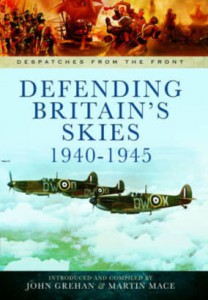The tittle already reveals it, Despatches from the front, and here they are the four soldiers to whom was entrusted the defending of the British airspace, by the War Office. The most known, and I also think most appealing person of them is, Air Chief Marshal Sir Hugh C.T. Dowding, who lead the Fighter Command during the Battle of Britain.
Next to the Fighter Command there was also the Anti-Aircraft Command (anti-aircraft) which was during the whole war under the command of General Sir Frederick A. Pile. That this land force General had been able to fulfil his duty so long, is probably due to the fact that he had the rare ability to work well and effectively together with his air force colleagues! After the Battle of Britain the Fighter Command went in November 1940 over to Air Chief Marshal Sir Sholto Douglas, who on his turn, in December 1941 was succeeded by Air Chief Marshal Sir Roderick Hill. This last one did, not even a week after D-Day, have to deal with the German deploy of a ramjet driven V-1 flying bomb and later the V-2 rocket. That was no slight task if you consider that about 10.000 V-1’s and 2.500 V-2’s were launched, which took 9000 civilian victims, devastated 200.000 houses and further demolished around a million other buildings.
At first I thought I had a curk dry report of findings (reports to the War Office) in my hands. But after a bit of ‘pushing through’ I found out that these reports, literally from the hands of the named four commanders, contained a lot of interesting explanations about their problems and their approach towards those problems. Though it seems that the land force and air force commanders apparently did not read each other’s reports, hence there are quite a few reports about the same issues. Each one of them also reports extensively about the German war methods. The great importance of holding on to the North Netherlands to credibly continue bombarding Great Britain, becomes clear.
Also the, for me complete new, weapon deployment like the use of the Heinkel HE III as flying launching platform for the V-1’s from Dutch territory is described in detail. Photos about this the book does not have, but on the internet there is more than enough photo information to be found.
The photo material in this book is, by the way, minimal. From General Pile there is not even a photo at all. Luckily the internet is able to easily-when desired- fill this gab!
What especially struck me is that the German Luftwaffe, despite the allied force majeure, kept its head cool and was able to offer resistance till the end of the war. And in such a way that the British Air defence had to continue to deploy ten thousands of men and dozens of squadrons from top quality fighters equipped with special modified jets. Paint was removed from the jets, they specially polished the hull and wings and 150 octane fuel was put in to press another 30 mph extra from the Merlin engines. All this was necessary to stand a chance against the fast V-1’s! Against the V-2 only the prevention of launching was effective. The dealing with that made that operations above Dutch territory, often in collaboration with the Dutch resistance movement, were most important. The garden of the nowadays residence of our Royal family served than as a good camouflaged launch place for the V-2’s!
Especially the detailed report of the operations of both camps up and above Dutch territory make this for the in WO II interested reader a particular interesting book. That reader needs to have perseverance though to be able to filter the interesting parts from the book. For me it was, after some accustoming to the report style, which apparently then was used for reporting to the War Office, possible to find the really fascinating parts. It is not so much an exciting, but a fascinating book.












Leave a Reply